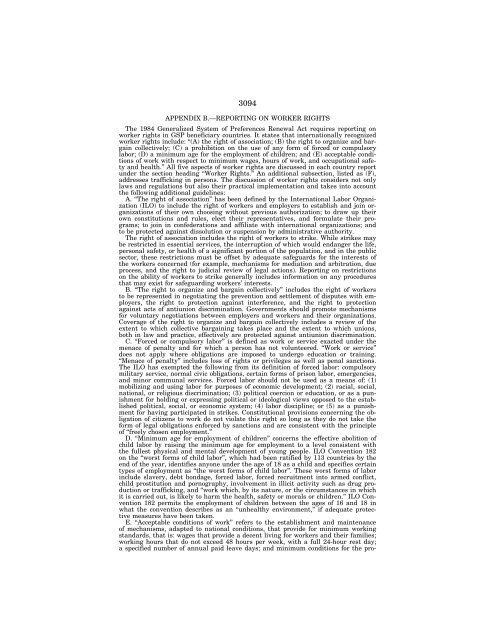APPENDIXES - House Foreign Affairs Committee Democrats
APPENDIXES - House Foreign Affairs Committee Democrats
APPENDIXES - House Foreign Affairs Committee Democrats
You also want an ePaper? Increase the reach of your titles
YUMPU automatically turns print PDFs into web optimized ePapers that Google loves.
3094APPENDIX B.—REPORTING ON WORKER RIGHTSThe 1984 Generalized System of Preferences Renewal Act requires reporting onworker rights in GSP beneficiary countries. It states that internationally recognizedworker rights include: ‘‘(A) the right of association; (B) the right to organize and bargaincollectively; (C) a prohibition on the use of any form of forced or compulsorylabor; (D) a minimum age for the employment of children; and (E) acceptable conditionsof work with respect to minimum wages, hours of work, and occupational safetyand health.’’ All five aspects of worker rights are discussed in each country reportunder the section heading ‘‘Worker Rights.’’ An additional subsection, listed as (F),addresses trafficking in persons. The discussion of worker rights considers not onlylaws and regulations but also their practical implementation and takes into accountthe following additional guidelines:A. ‘‘The right of association’’ has been defined by the International Labor Organization(ILO) to include the right of workers and employers to establish and join organizationsof their own choosing without previous authorization; to draw up theirown constitutions and rules, elect their representatives, and formulate their programs;to join in confederations and affiliate with international organizations; andto be protected against dissolution or suspension by administrative authority.The right of association includes the right of workers to strike. While strikes maybe restricted in essential services, the interruption of which would endanger the life,personal safety, or health of a significant portion of the population, and in the publicsector, these restrictions must be offset by adequate safeguards for the interests ofthe workers concerned (for example, mechanisms for mediation and arbitration, dueprocess, and the right to judicial review of legal actions). Reporting on restrictionson the ability of workers to strike generally includes information on any proceduresthat may exist for safeguarding workers’ interests.B. ‘‘The right to organize and bargain collectively’’ includes the right of workersto be represented in negotiating the prevention and settlement of disputes with employers,the right to protection against interference, and the right to protectionagainst acts of antiunion discrimination. Governments should promote mechanismsfor voluntary negotiations between employers and workers and their organizations.Coverage of the right to organize and bargain collectively includes a review of theextent to which collective bargaining takes place and the extent to which unions,both in law and practice, effectively are protected against antiunion discrimination.C. ‘‘Forced or compulsory labor’’ is defined as work or service exacted under themenace of penalty and for which a person has not volunteered. ‘‘Work or service’’does not apply where obligations are imposed to undergo education or training.‘‘Menace of penalty’’ includes loss of rights or privileges as well as penal sanctions.The ILO has exempted the following from its definition of forced labor: compulsorymilitary service, normal civic obligations, certain forms of prison labor, emergencies,and minor communal services. Forced labor should not be used as a means of: (1)mobilizing and using labor for purposes of economic development; (2) racial, social,national, or religious discrimination; (3) political coercion or education, or as a punishmentfor holding or expressing political or ideological views opposed to the establishedpolitical, social, or economic system; (4) labor discipline; or (5) as a punishmentfor having participated in strikes. Constitutional provisions concerning the obligationof citizens to work do not violate this right so long as they do not take theform of legal obligations enforced by sanctions and are consistent with the principleof ‘‘freely chosen employment.’’D. ‘‘Minimum age for employment of children’’ concerns the effective abolition ofchild labor by raising the minimum age for employment to a level consistent withthe fullest physical and mental development of young people. ILO Convention 182on the ‘‘worst forms of child labor’’, which had been ratified by 113 countries by theend of the year, identifies anyone under the age of 18 as a child and specifies certaintypes of employment as ‘‘the worst forms of child labor’’. These worst forms of laborinclude slavery, debt bondage, forced labor, forced recruitment into armed conflict,child prostitution and pornography, involvement in illicit activity such as drug productionor trafficking, and ‘‘work which, by its nature, or the circumstances in whichit is carried out, is likely to harm the health, safety or morals or children.’’ ILO Convention182 permits the employment of children between the ages of 16 and 18 inwhat the convention describes as an ‘‘unhealthy environment,’’ if adequate protectivemeasures have been taken.E. ‘‘Acceptable conditions of work’’ refers to the establishment and maintenanceof mechanisms, adapted to national conditions, that provide for minimum workingstandards, that is: wages that provide a decent living for workers and their families;working hours that do not exceed 48 hours per week, with a full 24-hour rest day;a specified number of annual paid leave days; and minimum conditions for the pro-VerDate 11-MAY-2000 13:07 Apr 08, 2002 Jkt 078290 PO 00000 Frm 01108 Fmt 6601 Sfmt 6621 F:\WORK\HUMANR\2001\78290.007 HINTREL1 PsN: HINTREL1










![Transcript [PDF] - House Foreign Affairs Committee Democrats](https://img.yumpu.com/34524080/1/190x245/transcript-pdf-house-foreign-affairs-committee-democrats.jpg?quality=85)




